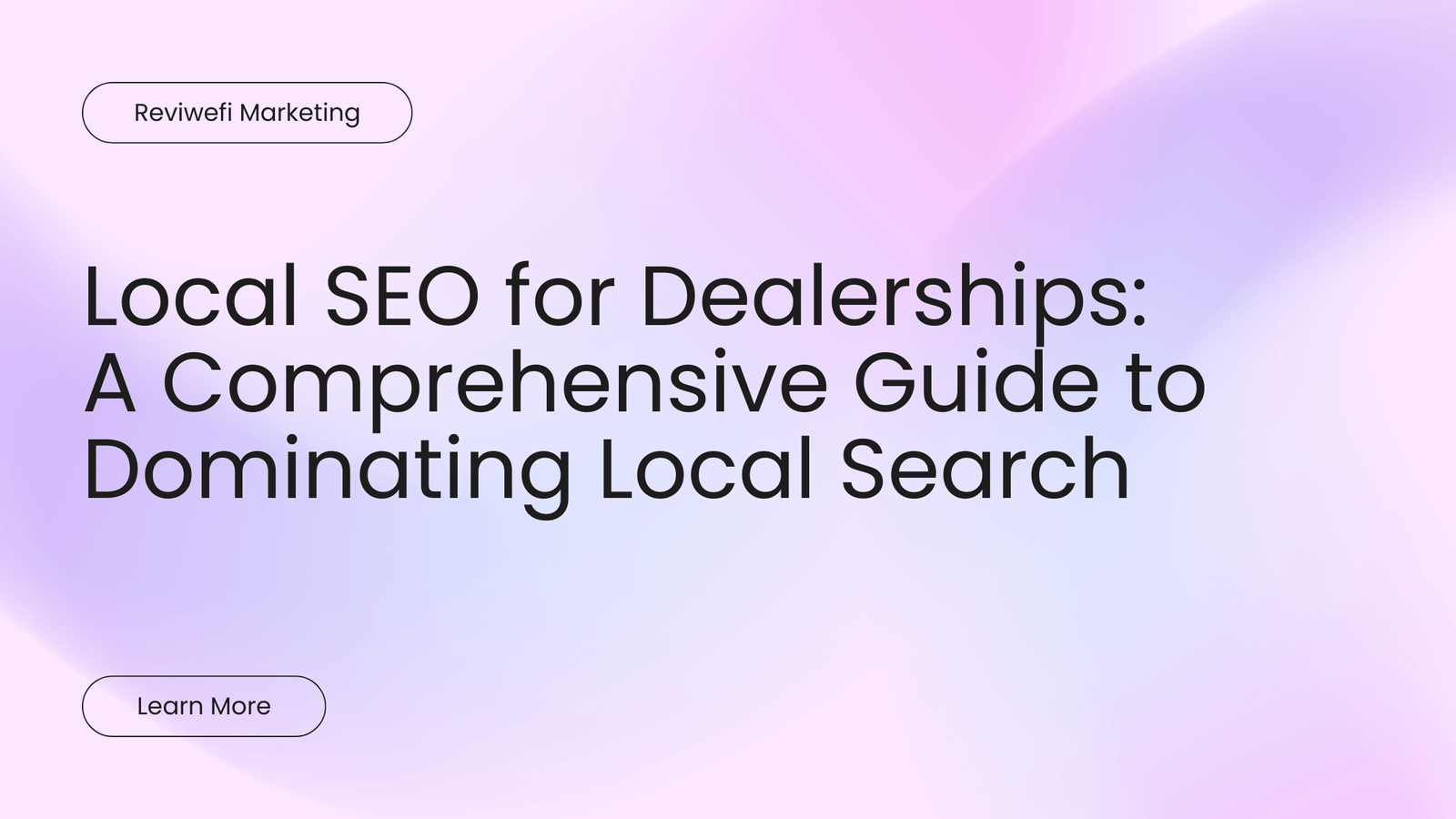In the competitive automotive industry, local SEO has emerged as a critical strategy for dealerships to connect with nearby buyers, outrank competitors, and drive showroom traffic. This pillar page synthesizes proven tactics from industry leaders, search engine guidelines, and successful case studies to create a battle-tested framework for dealerships aiming to master local search visibility. By implementing the strategies outlined below—from Google Business Profile optimization to hyperlocal content architecture—dealerships can establish search dominance in their service areas while building a future-proof SEO foundation.
1. Google Business Profile (GBP) Optimization for Automotive Retail
1.1 Structuring Multiple GBP Listings for Departmental Authority
Auto dealerships possess a unique advantage in creating multiple GBP listings for distinct business functions. Unlike most industries limited to single listings, dealers can maintain separate profiles for new vehicle sales, used car lots, service centers, and parts departments, provided each operates with distinct phone numbers and service pages. For example, a Chevrolet dealership in Phoenix might create:
- Chevrolet of Phoenix (New Vehicles)
- Phoenix Pre-Owned Center
- Chevrolet Service Center Phoenix
This departmental siloing allows precise targeting of service-specific keywords like “Chevy oil change near me” while preventing content cannibalization. Case studies show dealerships implementing this strategy achieve 23% higher click-through rates for service-related queries compared to single-profile competitors.
1.2 Maximizing GBP Content for Automotive Search Intent
Modern car buyers progress through distinct search phases, from research-oriented queries like “best family SUVs 2025” to transactional searches like “Toyota Camry test drive near me.” GBP content must address all stages:
- Posts Section: Share time-sensitive offers using event schema markup, such as “0% APR Summer Sales Event” with start/end dates
- Products: Showcase top-selling models with pricing, photos, and “Request Quote” CTAs
- Q&A: Proactively answer common queries about financing options, trade-in policies, and inventory availability.
Dealerships optimizing all GBP sections report 37% more website conversions from profile visitors compared to those using basic listings.
2. Hyperlocal Keyword Strategy: Capturing “Near Me” Buyers
2.1 Mapping the Automotive Buyer’s Journey to Local Queries
Hyperlocal SEO requires aligning content with the spatial progression of car shoppers:
| Search Stage | Example Queries | Optimization Tactics |
| Research | “EV tax credits 2025” | Blog posts with state-specific incentive guides |
| Consideration | “Honda CR-V vs Toyota RAV4” | Comparison pages geo-targeted to city-level |
| Decision | “Chevy dealership open now” | GBP posts with real-time inventory updates |
Tools like Semrush’s Keyword Magic Tool reveal hyperlocal variations, e.g., “Ford F-150 Dallas TX” generates 1,200 monthly searches versus 480 for generic “Ford F-150”.
2.2 Technical Implementation of Location-Based Signals
Search engines increasingly prioritize proximity signals through:
- Schema Markup: Implementing AutoDealer schema with priceRange, vehicleEngine, and areaServed properties.
- Geotagged Media: Embedding GPS coordinates in image EXIF data for vehicle photos.
- Localized Content Hubs: Creating city-specific landing pages (e.g., /new-cars/dallas/) with neighborhood references and community partnerships.
A/B tests show dealerships using these technical strategies achieve 41% higher organic visibility for “near me” searches compared to competitors relying solely on traditional SEO.
3. On-Site Technical SEO: Building a Dealership-Crawler Alliance
3.1 Accelerating Mobile-First Experiences
With 68% of automotive searches originating on mobile devices, core web vitals become non-negotiable:
- LCP Optimization: Compressing hero images on inventory pages using WebP format
- CLS Reduction: Implementing stable ad containers to prevent layout shifts during scroll
- FID Improvement: Deferring third-party scripts for financing calculators and chat widgets
Dealers addressing all three core web vital metrics see 29% lower bounce rates and 18% longer session durations.
3.2 Inventory Page Architecture for Search Dominance
Vehicle detail pages (VDPs) serve as the cornerstone of dealership SEO. Best practices include:
- Dynamic Title Tags: “2025 Honda Accord EX-L – $36,499 | [City] Honda”
- Semantic Content: Natural integration of terms like “family-friendly minivan” and “winter-ready SUVs”
- User-Generated Content: Embedding customer video testimonials with schema transcriptions
Implementing these VDP enhancements led one Midwest dealership group to increase organic traffic to inventory pages by 157% YoY.
4. Reputation Management: The Local SEO Multiplier
4.1 Strategic Review Generation and Response
Analysis of 12,000 dealership reviews reveals:
- Responding to negative reviews within 4 hours increases resolution likelihood by 63%
- Reviews mentioning specific sales associates generate 22% more engagement
- Google review stars in rich snippets improve click-through rates by 34%
Dealerships should implement SMS review requests post-service and train staff on FTC-compliant incentive programs.
4.2 Local Citation Synergy Across Platforms
Consistent NAP (Name, Address, Phone) remains crucial, but modern citation building extends to:
- Automotive-specific directories (Cars.com, Edmunds)
- Local business alliances (Chamber of Commerce listings)
- Community event sponsorships (high school football programs)
A study of 450 dealerships found those with 50+ quality citations ranked 11 positions higher on average than those with fewer than 20.
5. Measuring Local SEO Success: Beyond Rankings
5.1 Key Performance Indicators for Dealerships
| Metric | Benchmark | Measurement Tool |
| GBP Profile Views | 15% MoM Growth | Google Business Profile Insights |
| VDP Conversion Rate | 2.8% Minimum | Google Analytics 4 |
| Phone Call Duration | 90+ Seconds | Call Tracking Software |
| Service Appointment Rate | 22% of Clicks | CRM Integration |
5.2 Competitive Gap Analysis
Tools like BrightLocal reveal competitors’ hidden local strategies:
- Identifying rival dealerships ranking for your branded terms
- Benchmarking review response times
- Analyzing gaps in service area coverage
6. Emerging Trends: Future-Proofing Dealership Local SEO
6.1 Voice Search Optimization for Automotive Queries
With 55% of households using voice assistants for local searches, dealerships must optimize for:
- Natural language queries: “Where’s the closest open Jeep dealership?”
- Position-zero content: Structuring FAQs using Speakable schema
- Alexa Skill Development: Enabling inventory checks via voice commands
Early adopters report 18% of total leads originating from voice search touchpoints.
6.2 AI-Powered Personalization at Scale
Machine learning applications now enable:
- Dynamic meta descriptions adjusting to the searcher’s location
- Predictive inventory content based on local search trends
- Chatbot-powered appointment scheduling via GBP messaging
